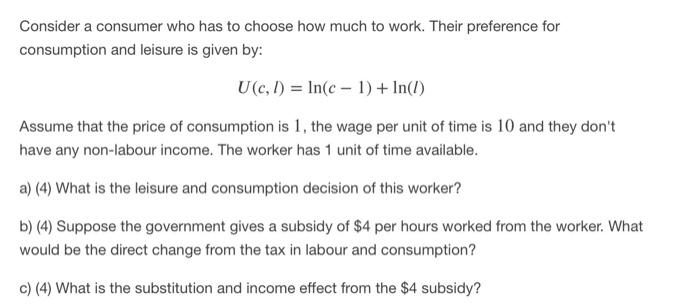Question
Consider a consumer who has to choose how much to work. Their preference for consumption and leisure is given by: U(c, 1) = ln(c-1)

Consider a consumer who has to choose how much to work. Their preference for consumption and leisure is given by: U(c, 1) = ln(c-1) + In(1) Assume that the price of consumption is 1, the wage per unit of time is 10 and they don't have any non-labour income. The worker has 1 unit of time available. a) (4) What is the leisure and consumption decision of this worker? b) (4) Suppose the government gives a subsidy of $4 per hours worked from the worker. What would be the direct change from the tax in labour and consumption? c) (4) What is the substitution and income effect from the $4 subsidy?
Step by Step Solution
3.50 Rating (157 Votes )
There are 3 Steps involved in it
Step: 1

Get Instant Access to Expert-Tailored Solutions
See step-by-step solutions with expert insights and AI powered tools for academic success
Step: 2

Step: 3

Ace Your Homework with AI
Get the answers you need in no time with our AI-driven, step-by-step assistance
Get StartedRecommended Textbook for
Investments Analysis and Management
Authors: Charles P. Jones
12th edition
978-1118475904, 1118475909, 1118363299, 978-1118363294
Students also viewed these Economics questions
Question
Answered: 1 week ago
Question
Answered: 1 week ago
Question
Answered: 1 week ago
Question
Answered: 1 week ago
Question
Answered: 1 week ago
Question
Answered: 1 week ago
Question
Answered: 1 week ago
Question
Answered: 1 week ago
Question
Answered: 1 week ago
Question
Answered: 1 week ago
Question
Answered: 1 week ago
Question
Answered: 1 week ago
Question
Answered: 1 week ago
Question
Answered: 1 week ago
Question
Answered: 1 week ago
Question
Answered: 1 week ago
Question
Answered: 1 week ago
Question
Answered: 1 week ago
Question
Answered: 1 week ago
Question
Answered: 1 week ago
Question
Answered: 1 week ago
View Answer in SolutionInn App



